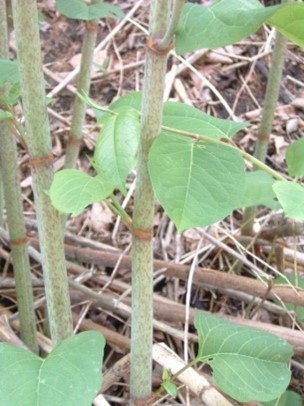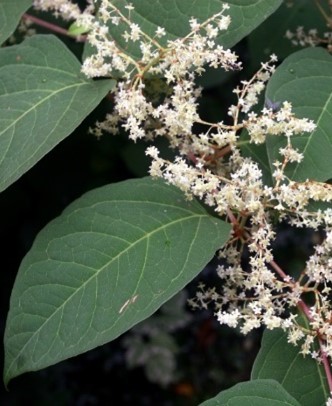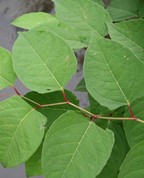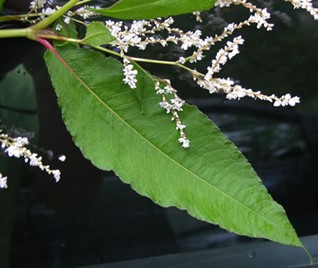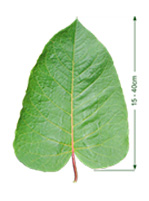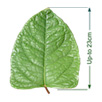Invasive knotweeds
Learn more about invasive knotweeds and how you can help prevent the introduction and spread of these invasive species.
What Ontario is doing
To prevent the further spread of invasive knotweeds in the province, Ontario has regulated the following as restricted invasive species under the Invasive Species Act, 2015.
- Japanese knotweed (Reynoutria japonica)
- bohemian knotweed (Reynoutria bohemica)
- giant knotweed (Reynoutria sachalinensis)
- Himalayan knotweed (Koenigia polystachya)
Learn about the Invasive Species Act and regulations.
Background
All four species of invasive knotweeds are perennial herbaceous plants that grow large, dense patches very quickly.
They can be found in a variety of habitats, including:
- riverbanks
- roadsides
- ditches
- backyards
- wetlands
- along fence lines
Preferring open sunny areas, they can also grow in shade and in many different soil types, provided there is enough moisture.
New populations can form from small root or stem fragments, which can accidentally be spread through contaminated soil on vehicles or construction equipment to invade new areas.
Range
These four knotweed species are native to eastern Asia including Japan, China and Korea. They have spread worldwide as prolific invaders. They were introduced to Canada in the early 1900’s.
In Canada, these species can be found in multiple provinces including British Columbia and Newfoundland.
All four knotweed species have been found in Ontario, but the Himalayan knotweed has not been reported in the wild.
View an up-to-date distribution map of invasive knotweeds in North America:
Impacts of invasive knotweeds
Due to its high growth rate, knotweeds can grow quickly to outcompete native plants for space, light, and soil nutrients, decreasing overall biodiversity.
Knotweed root systems cannot hold soil as well as native plants. This leads to erosion and destabilization of riverbanks, thereby reducing habitat quality for popular sport fish such as trout and salmon.
Knotweeds are capable of penetrating concrete and pavement, causing damage to infrastructure. This often leads to costly repairs and expensive plant removal.
Infestations along riverbanks may inhibit access to waterways for recreational activities.
How to identify invasive knotweeds
- These four species can grow larger than 2 m tall, with the giant knotweed being capable of reaching almost 5 m.
- Leaves are mostly heart-to-triangular shaped in all species except for the Himalayan, which are elongated and tapered.
- Giant knotweed leaves are twice as large as the other three species, which are 8 to 10 cm wide and 15 cm in length.
- Leaf shape resembles a dogwood or lilac species, but their leaves grow opposite each other on woody stems.
- All species bloom July to September, forming clusters of small flowers that are greenish-white, or pinkish white in Himalayan knotweed.
- Stems are smooth, hollow and green coloured. They grow in dense thickets and remain standing as bare stalks in winter. The Himalayan knotweed’s stem is redder in colour than the other three.
- The fruit of all four species are dark, smooth, and a few millimetres in size, however, the Himalayan knotweed is not winged.
What you need to know
- Learn how to identify invasive knotweeds and how to prevent the introduction or spread of this plant in Ontario.
- It is illegal to transport, deposit, release or bring invasive knotweeds into a provincial park or conservation reserve in Ontario.
- It is illegal to buy, sell, or trade invasive knotweeds or grow/plant invasive knotweeds in Ontario.
- Inspect and clean mud, seeds or plant fragments from clothing, cars or equipment like mowers before leaving an area with invasive knotweeds.
- Avoid travelling off-trail, especially in areas known to harbor invasive species like knotweeds
- Manage and remove invasive knotweeds using methods including digging, mowing or cutting. The most effective method will vary depending on the age and size of the infestation. For more information on invasive knotweed control, read the Best Management Practice Guidelines.
Reporting illegal activity
If you have any information about the illegal importation, distribution, or sale of invasive knotweeds, report it immediately to either:
- the ministry at
1-877-847-7667 , toll-free anytime - Crime Stoppers anonymously at
1-800-222-TIPS (8477)
If you’ve seen invasive knotweeds or another invasive species in the wild, please:
- contact the toll free Invading Species Hotline at
1-800-563-7711 - visit EDDMapS Ontario
- search for the ‘Invasive Species in Ontario’ project on iNaturalist.org to report a sighting
Gallery
Japanese Knotweed (Reynoutria japonica var. japonica). Photo: Rod Crick, Credit Valley
Giant knotweed (Reynoutria sachalinensis). Photo: Jan Samanek, Phytosanitary Administration, Bugwood.org licensed under a Creative Commons Attribution 3.0 License.
Bohemian knotweed (Reynoutria bohemica). Photo: Robert Vidéki, Doronicum Kft., Bugwood.org licensed under a Creative Commons Attribution-Noncommercial 3.0 License
Himalayan knotweed (Koenigia polystachya) produces spreading, loosely-branched clusters of pinkish-white to pink-coloured self-fertilizing flowers. Photo: The Knotweed Killers 2018.
Knotweed Leaf Identification
Photo: The Knotweed Killers 2018
Giant Knotweed (Reynoutria sachalinensis)
Plant Size: 4 to 5 m tall
Leaf size L/W: 15 to 40 cm, 2/3 as wide
Sex: Perfect and fertile, usually produces seed
Flower Colour & Arrangement: Green-white to cream-white with compact, drooping arrangement
Photo: The Knotweed Killers 2018
Bohemian Knotweed (Reynoutria bohemica)
Plant Size: 2 to 4 m tall
Leaf size L/W: 12 to 23 cm, 2/3 as wide
Sex: Female or Perfect, occasionally produces seed
Flower Colour & Arrangement: Green-white to cream-white with erect or loose, drooping arrangement
Photo: The Knotweed Killers 2018
Japanese Knotwood (Reynoutria japonica)
Plant Size: 1.5 to 3 m tall
Leaf size L/W: 10 to 17 cm, 2/3 as wide
Sex: Female or Perfect (rare), occasionally produces seed
Flower Colour & Arrangement: Green-white to cream-white with a loose, drooping arrangement
Photo: The Knotweed Killers 2018
Himalayan Knotwood (Koenigia polystachya)
Plant Size: 2 to 3 m tall
Leaf size L/W: 10 to 20 cm, 1/2 as wide
Sex: Perfect and fertile, usually produces seed
Flower Colour & Arrangement: Pinkish-white to pink with a loose, spreading arrangement
